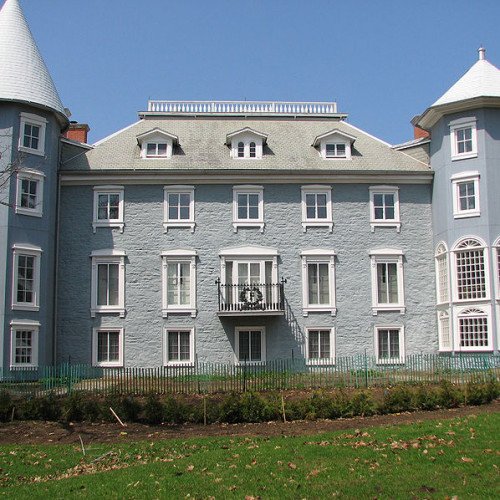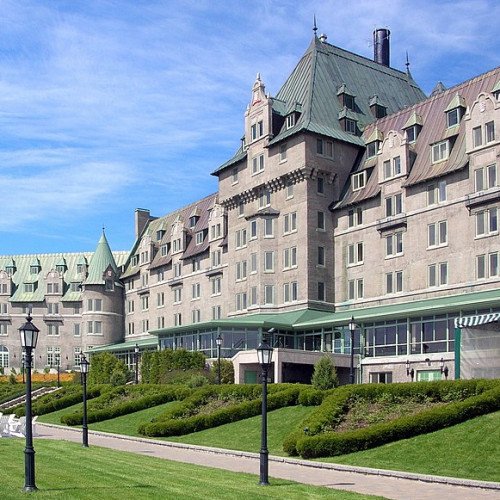Castles of "Canada" MANOIR PAPINEAU vs MANOIR RICHELIEU

MANOIR PAPINEAU
The ‘Manoir Papineau’ was home to the Papineau family from 1850 to 1929. The house along with outbuildings, landscaped gardens and grounds (including a gardner's cottage, family museum, tea house, granary and funeral chapel) are now open to the public and managed by Parks Canada who became the custodians in 1993; the site represents one of the most treasured heritage locations in the area surrounding La Petite-Nation and in the greater Ottawa River region. It was designed primarily to commemorate Louis-Joseph Papineau (1786-1871), the man who was to become a leading figure in Canadian politics during the 19th century, as the first French-Canadian nationalist leader. He later became the first seigneur of La Petite-Nation. The sumptuous house was built after Louis-Joseph Papineau returned from political exile in Europe, during the mid-1800s; he lived in the manor from 1846 with his wife and four children until his death. His descendants lived on at the house until the 1920s. Some of the more notable of these included his youngest daughter Azélie, mother to Henri Bourassa the famous journalist and founder of Canadian newspaper Le Devoir. Also, Talbot Mercer Papineau (great grandson of Louis-Joseph Papineau) lawyer and decorated soldier, one of four Canadians featured in the book Tapestry of War: A Private View of Canadians in the Great War, by Sandra Gwyn. Major Papineau was portrayed by his fifth cousin, twice removed, then future Canadian Prime Minister Justin Trudeau, in the Canadian Broadcasting Corporation's telefilm, The Great War. Built by Louis-Joseph Papineau between 1848 and 1850, the Manoir Papineau occupies a prominent spot overlooking the Ottawa River at Montebello, Quebec, Canada. The building's architecture, according to Parks Canada, “represents a blend of stylistic influences similar in many respects to that which is encountered in contemporaneous neoclassical villas. Its sculpted decor recalls the Greek Revival style. From the river, the house appears as a monumental elevation flanked by two corner towers. The facade and hip slopes of the roof present an overhang of unusual proportions, in a muted reference to the Regency style. The conic roof atop the stair tower built following a fire in 1892 is representative of the Queen Anne Revival. Finally, interior door openings between adjoining rooms were aligned to create particular interior perspectives, in keeping with French architectural tradition. The spiral staircase located in one of the towers also shows the influence of this tradition. The unusual positioning of the main reception rooms to the back of the ground floor, combined with the abundant fenestration on the lower two levels of the east tower, recall that a conservatory was once located here.” The interior of the Manor House is splendid, and is furnished with its original décor. Guided tours include the dining room; the grand salon (yellow room); the blue room; the bedroom of Louis-Joseph Papineau; and the seigneur's office and library tower.
Statistics for this Xoptio

MANOIR RICHELIEU
The Fairmont Le Manoir Richelieu is a historic hotel operated by Fairmont Hotels in La Malbaie, Quebec, Canada. The hotel was first built in 1899 but then burned down in 1928. The hotel was rebuilt in 1929 in the Châteauesque style, designed by Canadian architect John Smith Archibald in the style of a French castle. About 150 kilometres (93 mi) northeast of Quebec City, the hotel sits on a cliff along the St Lawrence River. It has 405 guest rooms and four restaurants. U.S. president William Taft opened the hotel's 27 hole golf course in 1925 which was designed by British architect Herbert Strong. The Casino de Charlevoix adjoins the hotel and can be accessed via an underground passage. It is owned by Fairmont and the Quebec government. Owned by Canada Steamship Lines, it was sold in 1966 to Warnock Hersey. In 1971, the hotel was sold to American real estate developer John B. Dempsey, II of Cleveland. He ran the hotel with a private ownership group until 1975 after which it was sold to the Quebec provincial government and then to Raymond Malenfant in 1985. In 1998, Loto-Québec partnered with Canadian Pacific Hotels (which became Fairmont) and the Solidarity Fund QFL to acquire the Manoir Richelieu. Fairmont Hotels rebranded and reopened the hotel in June 1999 after a $140 million renovation and expansion.